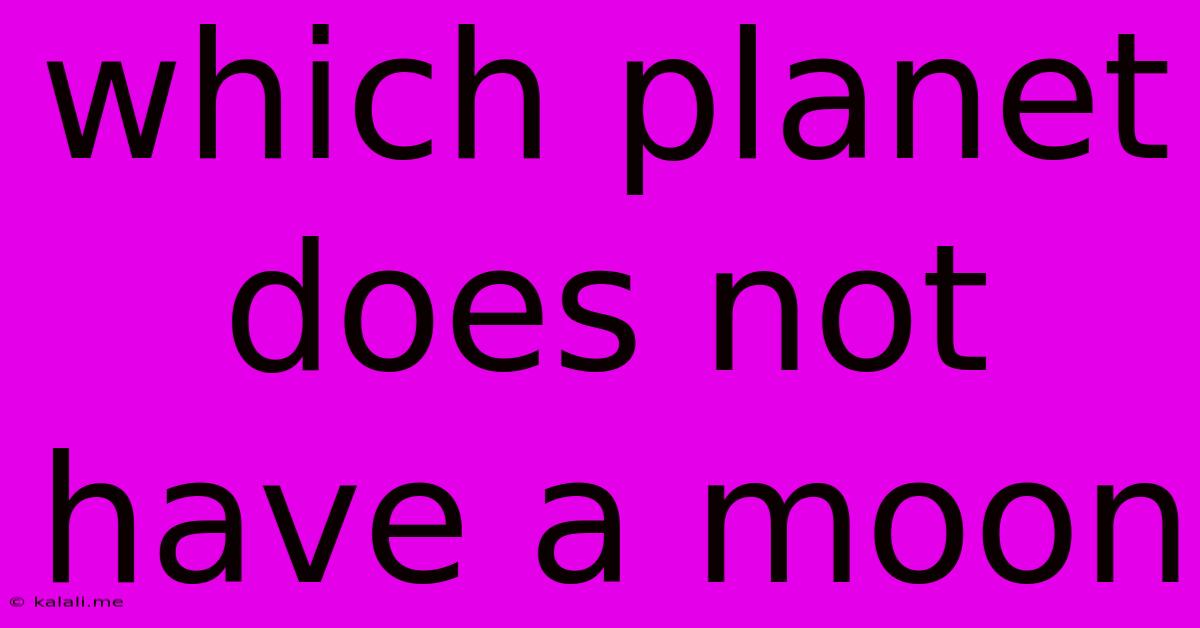Which Planet Does Not Have A Moon
Kalali
Jun 14, 2025 · 3 min read

Table of Contents
Which Planet Doesn't Have a Moon? A Surprising Answer and the Science Behind It
The solar system is a fascinating place, full of celestial bodies orbiting our sun. Many planets boast a retinue of moons, some large and some small. But one planet stands alone, surprisingly lacking any lunar companions. This article delves into the intriguing question: which planet doesn't have a moon? The answer might surprise you.
Mercury and Venus: The Moonless Planets
The answer is: Mercury and Venus. While many people automatically think of Mercury as the only planet without a moon, Venus also shares this unique characteristic. Both inner, rocky planets lack natural satellites. This fact prompts several interesting scientific questions about planetary formation and evolution.
Why Don't Mercury and Venus Have Moons?
The absence of moons around these two planets is a subject of ongoing scientific discussion, but several leading theories exist:
-
Gravitational Influence of the Sun: The sun's immense gravitational pull, especially close to its orbit, may have prevented the accretion of material necessary to form a moon around Mercury and Venus. Any smaller objects that might have formed nearby would likely have been pulled into the sun rather than becoming stable satellites.
-
Collisions and Orbital Dynamics: The prevailing theory of moon formation involves giant impacts. A large object colliding with a planet can eject debris into orbit, which eventually coalesces to form a moon (as is theorized for Earth's Moon). It's possible that the necessary impact events didn't occur for Mercury and Venus, or that the resulting debris was flung away by solar gravity. Orbital dynamics after such a collision also play a crucial role – a successful moon formation needs a stable orbital path.
-
Early Solar System Conditions: The conditions in the early solar system, near the sun, might have been inhospitable to moon formation. Higher temperatures and intense solar radiation could have hindered the accumulation of material. The volatile materials needed for moon formation may have simply evaporated.
Comparing Moonless Planets to Others
It's insightful to contrast Mercury and Venus with other planets in our solar system. Earth, for instance, has one large moon; Mars has two small moons; and the gas giants – Jupiter, Saturn, Uranus, and Neptune – possess numerous moons of varying sizes. The diversity in the number and characteristics of moons highlight the complex processes that shaped our solar system.
Understanding the lack of moons around Mercury and Venus helps us better comprehend planetary formation, evolution, and the dynamic interplay of gravitational forces in our solar system. Ongoing research and future missions may further illuminate the mysteries surrounding these moonless worlds. The question "which planet doesn't have a moon?" is a simple one, but the science behind the answer is anything but.
Future Research and Exploration
Continued research using advanced telescopes and space probes will undoubtedly provide more insight into the formation and evolution of Mercury and Venus. Further study could refine our understanding of the conditions present in the early solar system and how these conditions influenced the formation of planetary systems. This research will contribute to our larger knowledge of planetary science and the likelihood of finding moons (or their absence) around exoplanets.
Latest Posts
Latest Posts
-
If A Waves Frequency Doubles Its Wavelength
Jun 14, 2025
-
New Mexico State University Admission Requirements
Jun 14, 2025
-
What Is Not Required For Photosynthesis
Jun 14, 2025
-
Days To Celebrate In April 2024
Jun 14, 2025
-
What Is Not Found In A Animal Cell
Jun 14, 2025
Related Post
Thank you for visiting our website which covers about Which Planet Does Not Have A Moon . We hope the information provided has been useful to you. Feel free to contact us if you have any questions or need further assistance. See you next time and don't miss to bookmark.